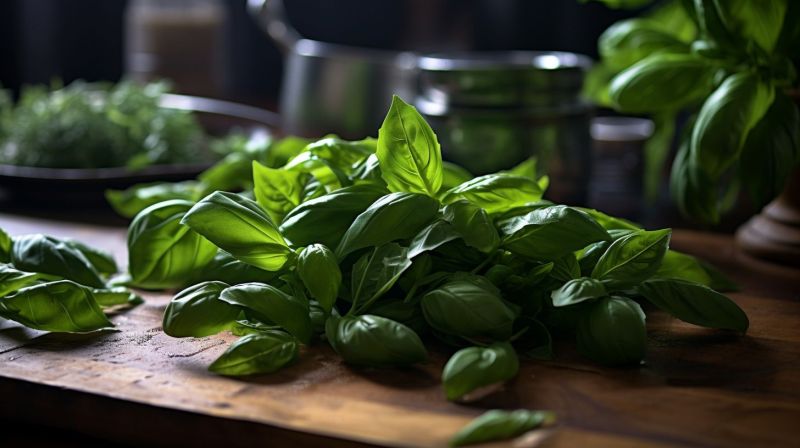Have you spotted those eye-catching purple basil plants at the nursery or farmer’s market? If you’re wondering whether you can eat purple basil the answer is a definite yes! This colorful herb offers both visual appeal for your garden and culinary versatility in the kitchen.
Is Purple Basil Edible?
Purple basil is just as edible as traditional green sweet basil It belongs to the same species, Ocimum basilicum The only difference is that it contains anthocyanins, the pigments responsible for its vivid purple hues.
These anthocyanins occur naturally in the outer surface cells of purple basil leaves. They do not affect flavor or make the basil toxic in any way.
So rest assured, any variety of colorful purple basil can be harvested and eaten just like any other culinary basil. The taste is similar to conventional green basils, with the same familiar, aromatic qualities.
Nutritional Benefits of Purple Basil
Beyond looking beautiful, purple basil offers some great nutrition. Like other basils, it provides:
-
Vitamin A – Important for eye health and a strong immune system.
-
Vitamin K – Supports proper blood clotting and bone strength.
-
Vitamin C – Boosts collagen production and acts as an antioxidant.
-
Iron – Needed to produce healthy red blood cells.
-
Calcium – Vital for bone density and muscular and neurological function.
In addition, the anthocyanins that give purple basil its color are powerful antioxidants that can help reduce inflammation, protect cells from damage, and lower the risk of chronic diseases.
So sprinkling colorful purple basil on your meals provides health benefits as well as visual appeal!
How to Use Purple Basil in Cooking
Purple basil can be used anywhere you would use traditional green sweet basil. Here are some tasty ways to incorporate it:
-
Make vivid purple pesto or chimichurri sauce. The color is stunning drizzled over pasta, fish, chicken, or veggies.
-
Use it to make a fragrant purplish basil vinegar.
-
Mix slivers into fresh salads – the color pops against greens.
-
Add whole leaves or ribbons to sandwiches and wraps for a pop of color.
-
Use as a garnish for soups, grains, eggs, meat, or seafood to dress up the plate.
-
Stir chopped purple basil into pasta sauces, tomato sauces, stir fries, etc. right at the end.
-
Infuse it into olive oil or vinegar to make herb-infused oils and vinegars.
-
Mix with garlic, lemon, and oil as a seasoning for roasted potatoes or veggies.
-
Make purple basil butter or cream cheese spread.
-
Use as part of a fresh herb bouquet garni added to stocks, soups, and stews.
Handling the Strong Flavor of Purple Basil
One thing to know about purple basil is that it often has a more pronounced flavor than regular green basil. This intense spice and clove-like taste works great in some dishes but can overpower more delicate ingredients.
Here are some tips for handling its bold flavor:
-
Start with smaller amounts until you know the strength of your particular purple basil. You can always add more.
-
Add it raw at the end of cooking instead of simmering it, which intensifies the flavor.
-
Balance it by pairing with milder herbs like parsley, cilantro, or chives.
-
Mix it with regular green basil to dilute the strength.
-
Use dried purple basil instead of fresh, as drying mutes some of the intensity.
So feel free to experiment with vivid purple basil. With a little trial and error, you’ll find delicious ways to enjoy its striking color and flavor.
Growing Your Own Purple Basil
One of the best parts of purple basil is how easy it is to grow yourself. Follow these simple tips:
-
Choose a variety suited to your climate – ‘Red Rubin’ and ‘Purple Ruffles’ are common.
-
Plant it in full sun (at least 6 hours) for the richest color. Partial shade dilutes the purple.
-
Water regularly but avoid wet leaves, which encourage mildew.
-
Pinch off flower buds to prolong harvest of leaves.
-
Harvest by cutting stems above a set of leaves. Frequent trimming encourages bushy growth.
-
Bring potted plants indoors before frost to overwinter. Take cuttings to propagate favorites.
With minimal care, you can grow abundant purple basil to take your cooking to new colorful heights. Once you try it, you may never want to go back to plain old green!
Purple Basil is great for…
Purple Basil leaves have a beautiful, coppery glow and clove-like, slightly spicy flavour. Use them in salads, for pesto or preserved in oils and vinegars.
- Olive oil
- Garlic
- Vinegar
- Pasta
- Fruits
- Eggplant
- Lettuce
- Cress
- Vegetables
- Anything tomato
Do not chop fresh Purple Basil leaves; instead, tear them up. The metal from the knife can change the taste. Like other types of basil, pick Purple Basil leaves just before you water them, when the stems are beginning to droop, for the best flavor. You’ll see that all the flavour is concentrated in the fragrant leaves.
shopping_basket Your basket
- No products in the cart.
Purple Basil is a cultivar of Ocimum basilicum (sweet basil). The dark purple leaves are used in pesto or as a garnish. This attractive basil variety has won multiple awards for its beauty, flavor and ease of cultivation.
How To Harvest Purple Basil
FAQ
Is purple basil safe to eat?
Does purple basil taste good?
Is purple basil different from regular basil?
Are purple basil flowers edible?
- The Ultimate Guide to Growing Strawberries in Raised Beds - August 8, 2025
- No-Dig Garden Beds: The Easiest Way to Grow a Beautiful Garden - August 6, 2025
- How to Protect and Preserve Wood for Raised Garden Beds - August 6, 2025

